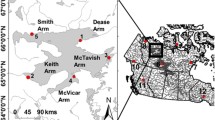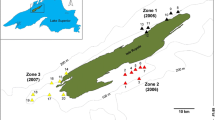Abstract
Humans have played a significant role in reducing levels of genetic diversity and differentiation of many teleost fishes, leading to homogenization across biological entities. We compare patterns of historical and contemporary genetic structure for three sympatric Great Lake’s lake trout (Salvelinus namaycush) morphs (lean, siscowet, and humper) that differ in patterns of habitat occupancy, susceptibility to overfishing and predation by invasive sea lamprey (Petromyzon marinus). Differential susceptibilities to overfishing and predation were expected to result in different impacts to levels of genetic diversity loss for each morphotype. Genetic data was collected for samples at three points in time: 1948 (pre-collapse), 1959 (collapse) and 1990s (current), corresponding to periods of intensive fishing, mortality due to lamprey and recovery, respectively. The lean morph preferentially targeted by the fishery and recognized as highly preyed upon by sea lamprey was more highly impacted genetically than other morphs, as evidenced by greater loss of genetic diversity first during the period of overfishing, then during the period of high sea lamprey abundance once the fishery collapsed. The siscowet morph also experienced genetic bottlenecks during the period of overfishing (pre-collapse period). Results indicate significant levels of genetic differentiation among morphs historically prior to declines in abundance and also among contemporary populations, suggesting that periods of population decline and resurgence in abundance and distribution did not result in loss of genetic distinctiveness among morphs.


Similar content being viewed by others
References
Allendorf FW, England PR, Luikart G, Ritchie PA, Ryman N (2008) Genetics effects of harvest on wild animal populations. Trends Ecol Evol 23:327–337. doi:10.1016/j.tree.2008.02.008
Belkhir K, Borsa P, Chikhi L, Raufaste N, Bonhomme F (1996–2004) Genetix, logiciel sous Windows™ pour la génétique des populations. Release 4.05. Laboratoire Génome, Populations, Interactions, CNRS UMR 5000: Université de Montpellier II, Montpellier, France.
Benjamini Y, Yekutieli D (2001) The control of false discovery rate under dependency. Ann Stat 29:1165–1188
Bergstedt RA, Argyle RL, Seelye JG, Scribner KT, Curtis GL (2003) In situ determination of the annual thermal habitat use by lake trout (Salvelinus namaycush) in Lake Huron. J Great Lakes Res 29(suppl 1):347–361
Bittner D, Excoffier L, Largiadèr CR (2010) Patterns of morphological changes and hybridization between sympatric whitefish morphs (Coregonus spp.) in a Swiss lake: a role for eutrophication? Mol Ecol 19:2152–2167. doi:10.1111/j.1365-294X.2010.04623.x
Bronte CR, Sitar SP (2008) Harvest and relative abundance of siscowet lake trout in Michigan waters of Lake Superior, 1929–1961. Trans Am Fish Soc 137:916–926. doi:10.1577/T07-096.1
Dunlop ES, Enberg K, Jørgensen C, Heino M (2009) Toward Darwinian fisheries management. Evol Appl 2:245–259. doi:10.1111/j.1752-4571.2009.00087.x
Eschmeyer PH, Phillips AM Jr (1965) Fat content of the flesh of siscowets and lake trout from Lake Superior. Trans Am Fish Soc 94:62–74
Eshenroder RL (2008) Differentiation of deep-water lake charr Salvelinus namaycush in North American lakes. Environ Biol Fish 83:77–90. doi:10.1007/s10641-007-9265-y
Garza JC, Williamson EG (2001) Detection of reduction in population size using data from microsatellite loci. Mol Ecol 10:305–318
Goetz F, Rosauer D, Sitar S et al (2010) A genetic basis for the phenotypic differentiation between siscowet and lean lake trout (Salvelinus namaycush). Mol Ecol 19(suppl 1):176–196. doi:10.1111/j.1365-294X.2009.04481.x
Gow JL, Peichel CL, Taylor EB (2006) Contrasting hybridisation rates between sympatric three-spined sticklebacks highlight the fragility of reproductive barriers between evolutionarily young species. Mol Ecol 15:739–752. doi:10.1111/j.1365-294X.2006.02825.x
Guinand B, Scribner KT (2003) Evaluation of methodology for detection of genetic bottlenecks: inferences from temporally replicated lake trout populations. C R Biol 326:S61–S67. doi:10.1016/S1631-0691(03)00039-8
Guinand B, Scribner KT, Page KS, Burnham-Curtis MK (2003) Genetic variation over space and time: analyses of extinct and remnant lake trout populations in the Upper Great Lakes. Proc R Soc B270:425–433. doi:10.1098/rspb.2002.2250
Hansen MJ (1999) Lake trout in the Great Lakes: basinwide stock collapse and binational restoration. In: Taylor WW, Ferreri CP (eds) Great Lakes fisheries policy and management: a binational perspective. Michigan State University Press, East Lansing
Hansen MJ, Peck JW, Schorfhaar RG et al (1995) Lake trout (Salvelinus namaycush) populations in Lake Superior and their restoration in 1959–1993. J Great Lakes Res 21(suppl 1):152–175
Harvey CJ, Schram ST, Kitchell JF (2003) Trophic relationships among lean and siscowet lake trout in Lake Superior. Trans Am Fish Soc 132:219–228
Heinrich JW, Mullett KM, Hansen MJ et al (2003) Sea lamprey abundance and management in Lake Superior, 1957 to 1999. J Great Lakes Res 29(suppl 1):566–583
Hutchings JA, Fraser DJ (2008) The nature of fisheries- and farming-induced evolution. Mol Ecol 17:294–313. doi:10.1111/j.1365-294X.2007.03485.x
Hutchinson WF, van Oosterhout C, Rogers SI, Carvalho GR (2003) Temporal analysis of archived samples indicates marked genetic changes in declining North Sea cod (Gadus morhua). Proc R Soc B 270:2125–2132. doi:10.1098/rspb.2003.2493
Jørgensen C, Enberg K, Dunlop ES et al (2007) Managing evolving fish stocks. Science 318:1247–1248. doi:10.1126/science.1148089
Kitano J, Bolnick DI, Beauchamp DA et al (2008) Reverse evolution of armor plates in the threespine stickleback. Curr Biol 18:769–774. doi:10.1016/j.cub.2008.04.027
Kitchell JF, Cox SP, Harvey CJ et al (2000) Sustainability of the Lake Superior fish community: interactions in a food web context. Ecosystems 3:545–560
Krueger CC, Ihssen PE (1995) Review of genetics of lake trout in the Great Lakes: history, molecular genetics, physiology, strain comparisons, and restoration management. J Great Lakes Res 21(suppl 1):348–363
Leberg PL (2002) Estimating allelic richness: effects of sample size and bottlenecks. Mol Ecol 11:2445–2449
Moore SA, Bronte CR (2001) Delineation of sympatric morphotypes of lake trout in Lake Superior. Trans Am Fish Soc 130:1233–1240
Nei M (1987) Molecular evolutionary genetics. Columbia University Press, New York
Nielsen EE, Hansen MM (2008) Waking the dead: the value of population genetic analyses of historical samples. Fish Fish 9:450–461. doi:10.1111/j.1467-2979.2008.00304.x
Olden JD, Poff NL, Douglas MR, Douglas ME, Fausch KD (2004) Ecological and evolutionary consequences of biotic homogenization. Trends Ecol Evol 19:18–24. doi:10.1016/j.tree.2003.09.010
Øostergard S, Hansen MM, Loeschke V, Nielsen EE (2003) Long-term temporal changes of genetic composition of brown trout (Salmo trutta L.) populations inhabiting an unstable environment. Mol Ecol 12:3123–3135. doi:10.1046/j.1365-294X.2003.01976.x
Page KS, Scribner KT, Burnham-Curtis M (2004) Genetic diversity of wild and hatchery lake trout populations: relevance for management and restoration in the Great Lakes. Trans Am Fish Soc 133:674–691
Palstra FP, Ruzzante DE (2010) A temporal perspective on population structure and gene flow in Atlantic salmon (Salmo salar) in Newfoundland, Canada. Can J Fish Aquat Sci 67:225–242. doi:10.1139/F09-176
Peck JW (1975) Brief life history accounts of five commercial salmonid fishes in Lake Superior. Fishery Research Report 1821, Michigan Department of Natural Resources: Ann Arbor
Petit RJ, El Mousadik A, Pons O (1998) Identifying populations for conservation on the basis of genetic markers. Conserv Biol 12:844–855
Rahrer JF (1965) Age, growth, maturity, and fecundity of “humper” lake trout, Isle Royale, Lake Superior. Trans Am Fish Soc 94:75–83
Rousset F (2008) GENEPOP’007: a complete re-implementation of the GENEPOP software for Windows and Linux. Mol Ecol Res 8:103–106
Ruzzante D, Taggart CT, Doyle RW, Cook D (2001) Stability in the historical pattern of genetic structure in Newfoundland cod (Gadus morhua) despite the catastrophic decline in population size from 1964 to 1994. Conserv Genet 2:257–269
Ryman N, Palm S (2006) Powsim: a computer program for assessing statistical power when testing for genetic differentiation. Mol Ecol Notes 6:600–602. doi:10.1111/j.1365-294X.2006.01378.x
Ryman N, Palm S, André C et al (2006) Power for detecting genetic divergence: differences between statistical methods and marker loci. Mol Ecol 15:2031–2045. doi:10.1111/j.1365-294X.2006.02839.x
Seehausen O (2006) Conservation: losing biodiversity by reverse speciation. Curr Biol 16:R334–R337. doi:10.1016/j.cub.2006.03.080
Seehausen O, Takimoto G, Roy D, Jokkela J (2008) Speciation reversal and biodiversity dynamics with hybridisation in changing environments. Mol Ecol 17:30–44. doi:10.1111/j.1365-294X.2007.03529.x
Sitar SP, Morales HM, Mata MT et al (2008) Survey of siscowet lake trout at their maximum depth in Lake Superior. J Great Lakes Res 34:276–286
Swanson B, Halverson M, Fisher S (1994) Historical lake trout catch for Wisconsin Lake Superior waters, 1936–1941. Great Lakes Fishery Commission, Lake Superior Committee Annual Meeting Minutes, Ann Arbor
Taylor EB, Boughman JW, Groenenboom M, Sniatynski M, Schluter D, Gow JL (2006) Speciation in reverse: morphological and genetic evidence of the collapse of a three-spined stickleback (Gasterosteus aculeatus) species pair. Mol Ecol 15:343–355. doi:10.1111/j.1365-294X.2005.02794.x
van Oosterhout C, Hutchison WF, Wills DPM, Shipley P (2004) Microchecker: software for identifying and correcting genotyping errors in microsatellite data. Mol Ecol Notes 4:535–538. doi:10.1111/j.1471-8286.2004.00684.x
Weir BS, Cockerham CC (1984) Estimating F-statistics for the analysis of population structure. Evolution 38:1358–1370
Weir BS, Hill WG (2002) Estimating F-statistics. Annu Rev Genet 36:721–750
Wilberg MJ, Hansen MJ, Bronte CR (2003) Historic and modern abundance of wild lean lake trout in Michigan waters of Lake Superior: implications for restoration goals. N Am J Fish Manag 23:100–108
Zimmerman MS, Schmidt SN, Krueger CC, Vander Zanden MJ, Eshenroder RL (2009) Ontogenetic niche shifts and resource partitioning of lake trout morphotypes. Can J Fish Aquat Sci 66:1007–1018. doi:10.1139/F09-060
Acknowledgements
This study was supported by the Great Lakes Fishery Trust, the Great Lakes Protection Fund, the Michigan Sea Grant College Program and the Partnership for Ecosystem Research and Management cooperative agreement between the Michigan Department of Natural Resources and Michigan State University. The authors thank M. Ebener, S. Libants, and S.P. Sitar for help and input at various stages of this project. Comments by anonymous reviewers improved the manuscript.
Author information
Authors and Affiliations
Corresponding author
Electronic Supplementary Materials
Below is the link to the electronic supplementary material.
ESM 1
(doc 109 kb)
Rights and permissions
About this article
Cite this article
Guinand, B., Page, K.S., Burnham-Curtis, M.K. et al. Genetic signatures of historical bottlenecks in sympatric lake trout (Salvelinus namaycush) morphotypes in Lake Superior. Environ Biol Fish 95, 323–334 (2012). https://doi.org/10.1007/s10641-012-0005-6
Received:
Accepted:
Published:
Issue Date:
DOI: https://doi.org/10.1007/s10641-012-0005-6




